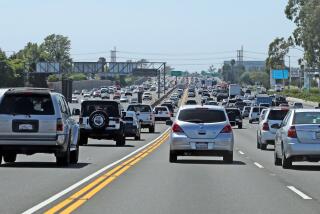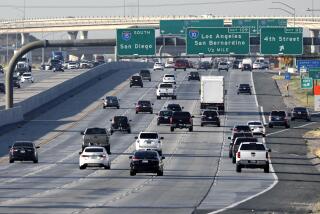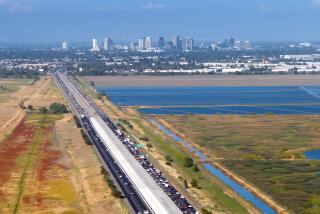Big Rig Drivers Chafe at Life in the Slow Lane
Walter Derden first took the wheel of a hulking big rig at the tender age of 15, becoming one of the first black truckers in Mississippi. And one of the youngest.
In the 50 years since, he has rolled through 48 of these 50 United States and Canada, hauling everything from pork skins to medical equipment in his red Freightliner truck.
“I’ve driven as far as you can drive on land,” Derden said proudly, adjusting his San Francisco 49ers baseball cap as he cooled his heels at Bull’s Truck Wash near downtown Los Angeles.
Derden now calls Sacramento home, but the veteran road warrior said he feels like a second-class citizen on California’s freeways.
The reason: Truckers in the Golden State must drive 55 mph or below and are, for the most part, restricted to the two slowest lanes. Other motorists can happily cruise at up to 70 mph.
California is one of only 10 states that impose slower speeds for trucks. Last year, California put teeth behind the slower speed limits: Commercial drivers caught exceeding the speed limit by more than 15 mph can face a more serious punishment than a citation. They can be charged with a misdemeanor.
Derden and his fellow truckers hate it. “I think it should all be the same speed,” he said, shaking his head.
In those states where all vehicles have the same speed limit, truckers are asphalt emperors, their 18-wheel behemoths ruling the highways like bull elephants on the African savanna.
In Texas, Arizona and Nevada, for example, truckers can speed along on the far left, known as “the hammer lane” because they can truly lay on the gas.
But when truckers cross the border into California, it’s life in the slow lane.
“I would love for them to let us in the hammer lane,” said J.R. Moseley, a 42-year trucker from Alabama. “It would be a lot less traffic and aggravation.”
The truck-speed issue is one of the most contentious topics of debate among truckers, roadway safety advocates and transportation experts. It is a debate that has revved up in recent years as several states considered changing speed limits for big rigs.
Texas raised truck speeds in 1999 from 60 mph to 70 mph. Ohio and Michigan recently rejected proposals to increase truck speeds. In 2000, legislation to reduce truck speeds in Arizona from 75 mph to 65 mph was defeated.
Both supporters and opponents of slower truck speeds claim their position promotes road safety. Each side cites studies and statistics.
“The research cuts both ways,” said Gerald Donaldson, a spokesman for Advocates for Highway and Auto Safety, a public interest group that supports slower truck speeds.
Opponents of slower speeds--most notably the American Trucking Assn.--say the risk of collisions increases when motorists sharing a road travel at different speeds.
That contention was supported by a 1994 federal study that said a driver traveling 10 mph slower or faster than prevailing traffic is six times more likely to be involved in an accident.
The Arizona Department of Transportation used that argument to oppose legislation aimed at reducing that state’s 75 mph truck speed limit.
“There is a potential safety hazard when cars and trucks are required to travel at different speeds,” said Mike Manthey, an Arizona state traffic engineer.
“Potential conflicts occur when more vehicles are passing one another, increasing the chances of crashes between cars and large trucks.”
But truckers aren’t the only ones who argue against the state’s differential in speed limits. Some roadway safety advocates--such as the National Motorists Assn. and Citizens for Reliable and Safe Highways, two national grass-roots organizations--have also urged keeping speed limits the same for all vehicles.
“Engineering studies have shown that if everyone is going at the same speed and the same flow of traffic, you are having a safer driving environment,” said Eric Skrum, a spokesman for the National Motorists Assn.
On the other hand, the argument for slower truck speeds usually comes down to this: A 40-ton big rig traveling at 65 mph takes 100 feet longer to stop than one traveling at 55 mph. On a crowded freeway, 100 feet can mean the difference between a close call and carnage.
Supporters of slower truck speeds, including the California Highway Patrol, argue that if truckers slow down, they can react more quickly and avoid more accidents.
Put simply: Speed kills.
“When you increase the speed on these things, you’ve got 65 feet or 75 feet of vehicle, weighing 80,000 pounds coming down the road,” said CHP Officer Richard Moss, who enforces commercial vehicle violations in Sacramento. “It’s difficult trying to get that monster to stop.”
To bolster their argument, supporters of slower truck speeds note that big rigs drive about 7% of all vehicles miles in the nation but are involved in 9% of all fatal collisions.
Most truckers are pressed to meet tight delivery schedules, and that often leads to speeding, Moss said. In fact, federal crash statistics show that speeding is a factor in about 20% of all fatal truck accidents nationwide.
But statistics like that don’t sway truckers like Ron “Shakey” Rudy, a ponytailed driver from Kansas who was recently hauling produce out of Los Angeles.
If truckers are forced to drive 15 mph slower than other traffic, he said, big rigs become a roadway hazard as faster, smaller passengers cars zip among and around them.
For that reason, Rudy admits that he and other truckers usually drive the prevailing freeway speed, even if it is 65 mph.
But isn’t it hard to stop a big rig at that speed?
“If a guy doesn’t know how to control a truck at that speed, then California shouldn’t have given him a license,” Rudy said angrily as he pulled away.
(BEGIN TEXT OF INFOBOX)
Truck Speed
Only 10 states impose slower maximum speed limits for trucks. Truckers say the slower speeds increase the chances of collisions between cars and trucks. Others argue that truckers should drive slower because it takes longer to stop a big rig.
State Car max. Truck max.
Arkansas speed speed
California 70 65
Idaho 70 55
Illinois 75 65
Indiana 65 55
Michigan 65 60
Montana 70 55
Ohio 75 65
Oregon 65 55
Washington 65 55
Source: American Trucking Assn., as of Feb. 1, 2001
More to Read
Sign up for Essential California
The most important California stories and recommendations in your inbox every morning.
You may occasionally receive promotional content from the Los Angeles Times.











